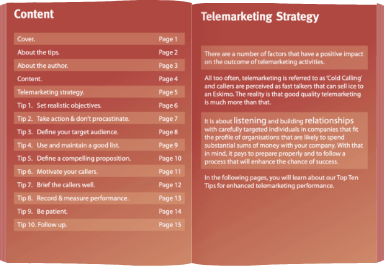Lead generation is something every business needs. Without a stream of new leads, it’s difficult to grow significantly. But have you got lead generation all wrong? Few businesses understand that b2b lead generation is as much a process as it is a service. And it needs a number of elements to work. To deliver the right number of qualified leads requires planning, time, and rigor in implementation. Poor leads sap the energy of your sales guys, waste time, and are probably worse than no leads at all.
It’s not unreasonable for companies that use outsourced telemarketing companies to expect their telemarketing supplier to manage the whole exercise for them. However, to get results it’s about shared responsibility and focused effort, and having the right process in place.
Increasingly, it’s also about a multi-channel approach. In other words, few businesses can afford to put all their business development eggs in one basket. There should be a blend of activities both outbound and inbound to generate qualified business opportunities. And these marketing routes to market support each other.
Below are some of our recommendations to help you get the most from your lead generation activities:
Work out who you want to target
Sounds obvious, doesn’t it? The key is to work out your Priority 1 targets in terms of the nature and size of business, decision-maker job role and location that you can profitably service. Once you know who you want to do business with, you are better placed to filter any data for outbound direct marketing (email, cold-calling, and so on) to the right type of business. It reduces wastage and simply put, costs you less in the long run. You can also focus any other relevant messages on your website and social pages on that same audience.
Work out what a lead looks like
Clients often say to us that they’d like 5-10 appointments per week for their sales team. The reality is that there’s a lot of difference between 5 and 10. It takes more time to deliver 10 qualified leads than it does to get 5. Results are likely to depend on all manner of factors such as the type of business being targeted, seniority of decision-makers, and how hard they are to reach. In addition, the level of market competition, length of current contracts, and quality of your proposition will play major roles in the results and ratios.
But, what does a lead actually look like? Is it only with someone with an immediate requirement within the next 3 months? That’s fine, but how many of those will we find? How much time do we need to deploy to achieve that number? Or is a lead the opportunity to engage with the right decision-maker in the right company with a view to unearthing an opportunity now and/or in the future? Does the lead need to be a face-to-face meeting or a web demo or a teleconference call?
Does the opportunity need to be in London with the CTO of a Financial Services company? How many employees or what turnover does the prospect company need to have in order to qualify as a good leader? And what’s the timescale for the opportunity with that company? Is it 3 months or less? Does the target decision-maker need to be specifically interested in a new CRM deployment? And does the project need to be > £100k? The above criteria are precise but also more challenging than simply arranging a phone call with an IT manager of a company anywhere in the UK that’s an SME.
We had a call recently from a client who simply said they want to target Toy Manufacturers. I imagine that there are tons of ‘mom and pop’ type businesses producing toys that exhibit at the Spring Fair in Birmingham. But are they big enough for our client? Would they bring enough revenue in?
The point is that we need to work out the criteria for lead generation and what a sales appointment or opportunity looks like.
Work out your ROI
ROI isn’t generally measured in days and weeks. If we consider the points above, we’re looking for senior decision-makers with budget authority. BANT is an acronym regularly used in business development. It means Budget, Authority, Need, and Timescale. The point is that opportunities worth significant sums don’t pop up every 5 minutes. That’s especially true where there is a need to go out to tender, undertake testing and feasibility, gain board approval, and so on. Therefore, you generally need to evaluate the viability of lead generation over a defined period. If it takes 6 months or more to get an appointment with the IT Director of BT or Tesco and another 12 months for their incumbent supplier contract to come to an end, surely that’s still a great lead.
We have engaged with them and identified the contract renewal date well in advance. If that comes to fruition, it’s even better if the contract is worth £250k-£1mover time. But, how much lead generation effort is needed to reach Tesco and BT and companies of that ilk? And how much is each lead of that magnitude worth? If it costs £20,000 to secure a contract worth £250,000, is that a worthwhile investment?
Lead generation is a long game, not a short game, especially at the senior level. And it’s important to evaluate and measure success over a reasonable period. Research from the DMA Contact Centres & Telemarketing Council puts the ROI for b2b telemarketing at 11:1. In the same study, 93% of respondents advised that telemarketing is an effective way to generate leads.
Take an integrated approach
Are all of your eggs in one basket? Do you rely on telemarketing alone? Or just email marketing. Today’s lead generation needs to be multi-faceted. One size most definitely doesn’t fit all. We all respond in different ways and to different means of communication. I was always taught in ‘marketing school’ that you need to reach your potential customers wherever they consume information.
We recommend a blend between inbound and outbound for b2b lead generation. Outbound includes telemarketing, email, direct mail, and so on. Some time ago, people were predicting the death of both telemarketing and direct mail. Yet they’re still going strong. Research conducted by The Direct Marketing Association in Sept 2014 found that telemarketing is still a potent ingredient in the marketing mix for businesses. The report also concludes that email and telemarketing fit nicely together for lead generation. According to the DMA research below, the top reasons for using telemarketing are to generate leads (84%), to make appointments (79%), and to nurture leads over time (68%).

Direct Mail is perhaps the forgotten tool in the toolbox of many businesses doing b2b lead generation. One of our telemarketing clients recently crafted a superb piece of direct mail including an auto-play video that went to the top 50 independent schools in the UK. The mailer itself generated a good response and it provided the telemarketing caller with a good reason to engage.
Inbound lead generation using social media and content marketing is desirable since it builds your business credibility and encourages people to come to you. This could be via a Google search, LinkedIn, referrals, and the like. Clearly, the strongest inbound method is referral/recommendation but we shouldn’t ignore the role that content plays in this. If you do a good job, hopefully, recommendations will flow.
But what about your wider network of contacts on LinkedIn and Facebook? If you provide them with a steady and relevant stream of insight, they’re much more likely to recommend you when a need arises and to use you when they have a personal need for lead generation. The same research by the DMA shows that content is fundamental in building engagement and credibility and thereby supports lead generation through other means.

The reason is simple. Imagine you’ve just made a telemarketing cold call. Every prospect will check out your website. What will they find when they get there? A brochure site with no valuable content other than a list of services? Or do they find information and insight that gives them a warm feeling about your business and validates a reason to work with you? Social media usage is so ingrained for Millennials that they will check both you and your company out on LinkedIn, Twitter, Google+, and Facebook.
If you have videos, they may watch them build a picture of who you are and whether they’d like to do business with you. If your business has a visual element to what you provide, you may need to consider Instagram or Pinterest to support your credibility. If you’re not present or you’re inactive on social channels, what is their impression of your business likely to be?
Do you have a white paper that would add value to your target audience? Are you planning a webinar on a hot topic? How about a round table breakfast or lunch with an industry influencer? Do you write interesting blog articles like this one and publish them on your website and social pages? I received a prospect call recently from a chap I met some time ago. During the conversation he said it’s been a while since we’ve spoken but ‘I always read your articles on LinkedIn’.
These and other activities are core inbound lead generation activities but they also enhance outbound. They’re a reason to engage and conversation is all-important on a sales call rather than a sales pitch.
So, have you got lead generation all wrong? Effective lead generation provides opportunities for your business to generate short-term new business. But, most importantly, it’s also about the long term. It’s about lead nurturing and pipeline management. That means reaching your target audience over a period of time with different stimuli that either encourage them to come to you or paves the way for more engaging conversations when you reach out to them.
However you handle lead generation, you need to ensure that your reputation is enhanced and not compromised. Business development requires time and effort and coordination to be really effective. Leads don’t generally just magically appear and large organizations aren’t waiting around for your call. Senior decision-makers are bombarded with sales messages by phone, email, inmails, direct mail, and so on. Therefore, if you want to generate ROI, you need:
-
-
- Careful qualification
- Tailored messages
- A reason for prospects to engage that isn’t just a sales pitch
- A blended approach
- Content on your website and social presence to back up your credibility
- A fully worked through the sales process
- Lead nurturing and pipeline management
- Clear reporting and measurement
-
If you follow these steps, your sales funnel is likely to remain full and, over time, your business will reap the benefits.
If you’d like to know how GSA Business Development can help generate growth for your business or book one of our new business development and marketing strategy workshops, contact us now on 0845 658 8192 or use the form on this site.






